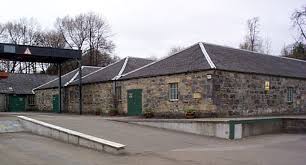Distillery Object: {"about":"Despite being a relatively small and obscure distillery, Glen Spey has a rich and intriguing history. Over the years, Glen Spey has shared the town of Rothes with four other distilleries: Glenrothes, Glen Grant, Speyburn, and Caperdonich. Glen Spey’s production is relatively modest in comparison to its neighbors, which explains why it has gone relatively unnoticed for so long.\n\nGlen Spey started its life as an oatmeal mill. It’s founder, James Stuart, was a corn merchant before he branched out into Whisky. The distillery was founded in 1878, with Stuart simply added the distillery’s equipment to the building. In 1887, it was sold to the London-based Gilbey Company, and despite a small fire in 1920, and expansion in 1969-70, went about its business relatively uneventfully for almost a century. The majority of the spirit produced at the site was used in Gilbey’s Spey Royal Blend, with no real official bottlings occurring.\n\nIn 1962, W\u0026A Gilbey and Company merged with United Wine Traders, the owners of Justerini \u0026 Brooks, who were responsible for the production of J\u0026B Blended Whisky. In 1970, the number of stills were increased from two to four, bringing the distillery’s production capacity to its modern-day level. Under the merge, Glen Spey became a major part of the J\u0026B Blend. Glen Spey survived a series of corporate mergers in the late twentieth century, finally resulting in Diageo obtaining the site. 2001 was an important year in the history of the distillery, bringing the first official bottling – a 12 year-old, released as part of Diageo’s Flora and Fauna range.\n\nGlen Spey also has the distinction of being the only Rothes distillery to boast a ghost. The story of the ghost dates back to the Second World War, when a solider posted at the distillery was tragically electrocuted in an accident. It is said that his spirit still roams the site at night.\n\n","headline":"Glen Spey Distillery","image_or_video":"gid:\/\/shopify\/MediaImage\/63515310326136","name":"Glen Spey"}
Distillery Name: Glen Spey
Distillery Headline: Glen Spey Distillery
Distillery About: Despite being a relatively small and obscure distillery, Glen Spey has a rich and intriguing history. Over the years, Glen Spey has shared the town of Rothes with four other distilleries: Glenrothes, Glen Grant, Speyburn, and Caperdonich. Glen Spey’s production is relatively modest in comparison to its neighbors, which explains why it has gone relatively unnoticed for so long. Glen Spey started its life as an oatmeal mill. It’s founder, James Stuart, was a corn merchant before he branched out into Whisky. The distillery was founded in 1878, with Stuart simply added the distillery’s equipment to the building. In 1887, it was sold to the London-based Gilbey Company, and despite a small fire in 1920, and expansion in 1969-70, went about its business relatively uneventfully for almost a century. The majority of the spirit produced at the site was used in Gilbey’s Spey Royal Blend, with no real official bottlings occurring. In 1962, W&A Gilbey and Company merged with United Wine Traders, the owners of Justerini & Brooks, who were responsible for the production of J&B Blended Whisky. In 1970, the number of stills were increased from two to four, bringing the distillery’s production capacity to its modern-day level. Under the merge, Glen Spey became a major part of the J&B Blend. Glen Spey survived a series of corporate mergers in the late twentieth century, finally resulting in Diageo obtaining the site. 2001 was an important year in the history of the distillery, bringing the first official bottling – a 12 year-old, released as part of Diageo’s Flora and Fauna range. Glen Spey also has the distinction of being the only Rothes distillery to boast a ghost. The story of the ghost dates back to the Second World War, when a solider posted at the distillery was tragically electrocuted in an accident. It is said that his spirit still roams the site at night.
Hide Distillery: false
Hide Tasting Notes: false
Hide Details: false
Hide Region: false
about the distillery
Glen Spey Distillery
Despite being a relatively small and obscure distillery, Glen Spey has a rich and intriguing history. Over the years, Glen Spey has shared the town of Rothes with four other distilleries: Glenrothes, Glen Grant, Speyburn, and Caperdonich. Glen Spey’s production is relatively modest in comparison to its neighbors, which explains why it has gone relatively unnoticed for so long.
Glen Spey started its life as an oatmeal mill. It’s founder, James Stuart, was a corn merchant before he branched out into Whisky. The distillery was founded in 1878, with Stuart simply added the distillery’s equipment to the building. In 1887, it was sold to the London-based Gilbey Company, and despite a small fire in 1920, and expansion in 1969-70, went about its business relatively uneventfully for almost a century. The majority of the spirit produced at the site was used in Gilbey’s Spey Royal Blend, with no real official bottlings occurring.
In 1962, W&A Gilbey and Company merged with United Wine Traders, the owners of Justerini & Brooks, who were responsible for the production of J&B Blended Whisky. In 1970, the number of stills were increased from two to four, bringing the distillery’s production capacity to its modern-day level. Under the merge, Glen Spey became a major part of the J&B Blend. Glen Spey survived a series of corporate mergers in the late twentieth century, finally resulting in Diageo obtaining the site. 2001 was an important year in the history of the distillery, bringing the first official bottling – a 12 year-old, released as part of Diageo’s Flora and Fauna range.
Glen Spey also has the distinction of being the only Rothes distillery to boast a ghost. The story of the ghost dates back to the Second World War, when a solider posted at the distillery was tragically electrocuted in an accident. It is said that his spirit still roams the site at night.







